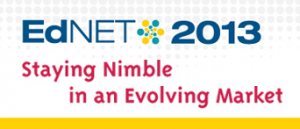
EdNet — what a tremendous event put on by MDR. It’s called the “adult event” of the Education Technology Industry because one is not only able to see the President of the McGraw-Hill School Education Group sitting next to the CEO of Pearson North American Education discussing industry related topics, but also able to sit down with representatives of large companies like Microsoft and Intel over a cup of coffee discussing the history, the here and now, and the future of education technology. I left feeling I gained a great deal of new insight into the business and gained new colleagues in the industry.
This event brings together over 200 companies and 550 professionals from various countries to discuss all aspects of the Education Technology. And the founder 25 years ago, Dr. Nelson Heller is still leading the charge from the kickoff of the event, continually strolling in the networking lobby, through the closing remarks.
Of my 20 years of attending events, this had the best mix of content and networking. Industry leaders welcomed, met with and helped newbies, making sure they interacted meaningfully before leaving Denver. I strongly recommend any company doing business with educational institutions attends this event.
Rather than give you a blow-by-blow of the proceedings, I’ll share with you what, in my view, constituted the major event highlights:
- Anne Wuljcik, Editor of EdNet and Brian Sigritz, Director of State Fiscal Studies painted a glass is half full picture due to uncertainties related to future K12 and Higher Education funding. They believe the funding decline is behind us and going forward, there will be minimal growth rather than a big spurt of growth as the industry has received in the past. This news tells me the education business’ need is to make sure they have predictable education and business processes and to maximize the quality of its products for the education institutions and sales for the investors, while keeping costs controllable for sustainability.
- Clement Erbmann, Managing Director, First Analysis Corporation and Harold Levy of Palm Ventures backed this thought of efficiency, as did my chance lunch meeting with another education investing company principal. He wants to see revenue traction, limitation in niche plays and the ability to show a growth pattern to $100 million in revenue.
- Dr. Heller elaborated on the many opportunities available in the international market
- Russia choosing tablets over textbooks
- India 2% national educational tax
- Mexico’s 4.5 million laptops for students
- Thailand’s 5 million tablets for students
- At the Birds of Feather Roundtable on Marketing, we discussed the following statistics and topics from Education Week’s survey of marketing leaders showing 92% of marketing departments are performing a more complex job than 3 years ago:
- 70% of the buying cycle is handled by the Marketing Content, Branding, and Lead Management Process, meaning customers don’t want to speak with a sales rep until they have done their own prioritization of needs, searching for solutions, and limiting of options.
- Marketing Departments are only being judged on the QUANTITY of leads they provide, rather than on the QUALITY. Less than 30% of the Sales Leadership is satisfied with the lead quality and only 36% is happy with the quantity of leads being provided to the sales team.
- Since sales people are not following up with long term leads, marketing worries the work they have done on behalf of the company and its products will go to waste.
- There seems to be a lot of ambiguity in terms of who the proper decision maker is and to whom messaging should be directed in education institutions. CEOs envision the Superintendent, Product Developers – Teachers, CMO – Curriculum Leaders, while VP of Sales thinks it’s the school principals.
Luckily, Karen Cator, President and CEO of Digital Promise, started off the conference in her keynote address informing us all to be proud of what has been accomplished and what is going right. We were told of her belief (and later confirmed by Dr. Heller in closing statements) that one of the key issues limiting the EdTech Market is the continuing discussion of what’s WRONG rather than to focus on the positive — instilling doubt in the educators, politicians, and parents’ minds and plans. Companies continue to create great engaging education tools with gaming capabilities maximizing individual and personalized learning, while being able to demonstrate the learner’s competence of the information, in the same time attaining the Common Core and STEM goals and keeping creativity of the learner brewing.
So, let’s go out and invest in communicating all the positive messages by turning up the conversations with all the various 38 vehicles of information distribution (cold calling, emailing, social media, advertising, tradeshows, direct mail, etc…) rather than limiting ourselves to just one or two. We just don’t know the specific who, where, when and how of the decision making process and so we must use all channels to reach and influence the decision makers. As DMP proved in the past, the cheapest lead to attain may be the most expensive to convert to a sale. What you can do is make sure the information, research and branding is created, delivered, maintained and ready at a moment’s notice.